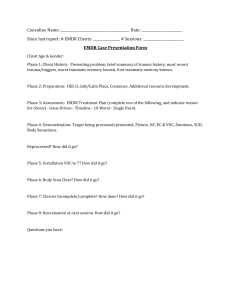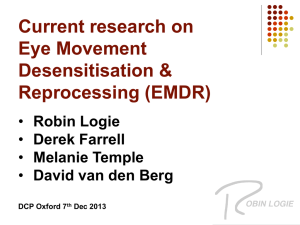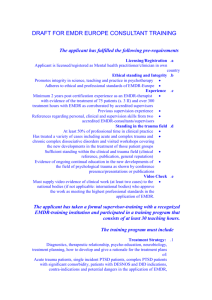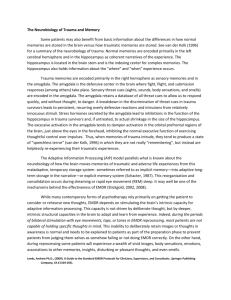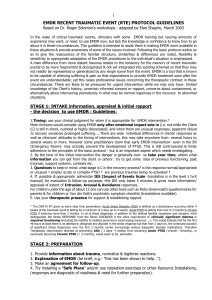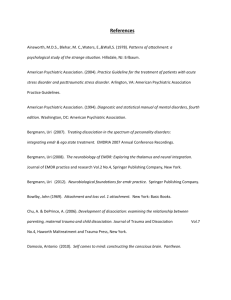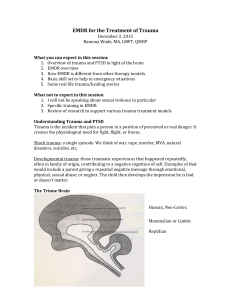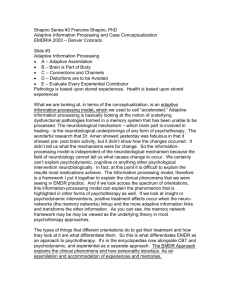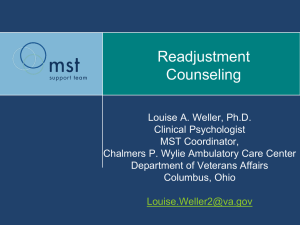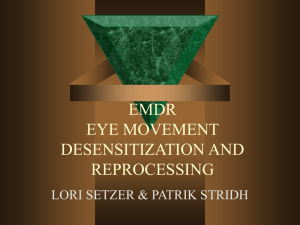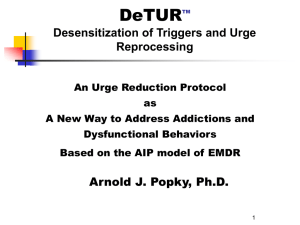Kasey Brady, MSSW, LCSW
advertisement
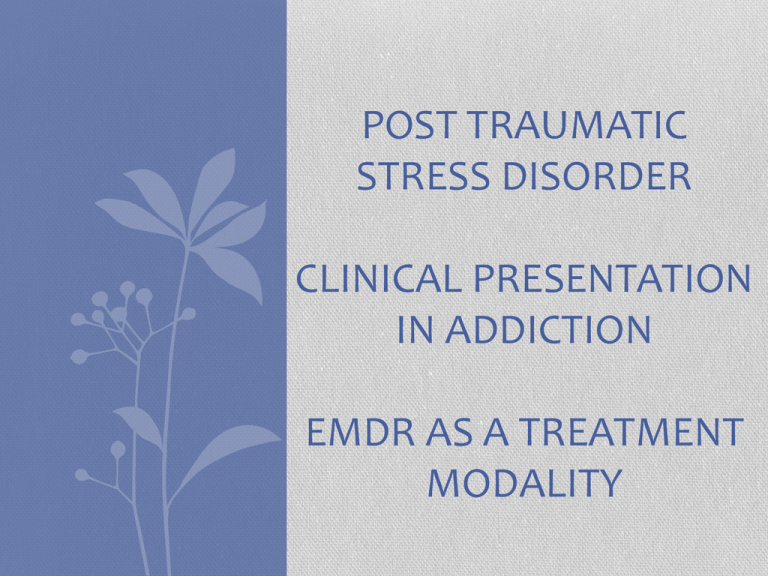
POST TRAUMATIC STRESS DISORDER CLINICAL PRESENTATION IN ADDICTION EMDR AS A TREATMENT MODALITY I. Introduction • Kasey Brady, LCSW • Private practice in Louisville, KY • Trauma (PTSD), Anxiety, Depression, Addiction and Couples • Member of NASW and EMDRIA II. Text Book of AA (The Big Book) References PTSD • “We are unable, at certain times, to bring into our consciousness with sufficient force the memory of the suffering and humiliation of even a week or a month ago.” Page 24, Chapter 2, “There is a Solution” • “An illness of this sort – and we have come to believe it an illness – involves those about us in a way no other human sickness can.” “…for with it there goes annihilation of all the things worthwhile in life. It engulfs all whose lives touch the sufferer’s. It brings misunderstanding, fierce resentment, financial insecurity, disgusted friends and employers, warped lives of blameless children, sad wives and parents – anyone can increase the list.” Page 18, Chapter 3, “There is a Solution” • Fred’s story “Not only had I been off guard, I had made no fight whatever against the first drink. This time I had not thought about the consequences at all.” Page 41, Chapter 3, “More About Alcoholism” • “…for what I had learned of alcoholism did not occur to me at all…I saw that will power and selfknowledge would not help in those strange mental blank spots.” Page 42, Chapter 3, “More About Alcoholism” III. Discussion of Trauma A. Childhood 1. Physical 2. Sexual 3. Emotional 4. Verbal B. Adult/Adolescent 1. Traumatic events prior to drinking and drugging 2. Traumatic events while drinking and drugging (behaviors that step on personal values and morals, i.e., sleeping around, abortions, violent behavior) C. Types of Trauma 1. Acute (accidents, arrests, abortions, violence, etc.) 2. Chronic (emotional abuse, verbal abuse, sexual abuse, elevated fight, flight or freeze response, etc.) D. Avoidance of Trauma Reality 1. Denial 2. Rationalization 3. Minimization 4. Disassociation 5. Compartmentalizing E. Triggers for Trauma Memories 1. Dreams/Nightmares 2. Music 3. Smells 4. Loud noises 5. Conflict 6. Confrontation 7. Shame IV. Untreated Trauma as a Reason for Relapse A. Old beliefs and old ideas 1. Not good enough 2. Not lovable (by others and Higher Power) 3. Permanently damaged B. Secrets C. Disconnect between the head (cognitive) and the heart (emotional) D. Inability to forgive self and/or others E. Need for relief from psychic pain F. Impaired coping mechanisms V. Patient Presentation A. Are they actively using? B. Detoxed from recent relapse? C. Previous treatment? 1. Rehab (inpatient or IOP) 2. Psychiatric care 3. AA (now or prior to relapse) VI. History Taking A. Family of Origin 1. Roles 2. Dynamics (physical, verbal, emotional) 3. Current Interactions B. Current Relationship(s) 1. Roles 2. Dynamics (physical, verbal, emotional) 3. Current Interactions C. Work Relationships 1. Roles 2. Dynamics (physical, verbal, emotional) 3. Current Interactions D. Presenting Problem (other than relapse) 1. Trauma (Acute and/or Chronic) 2. Resulting beliefs about self 3. Resulting behaviors based on beliefs about self 4. Traumas perpetrated on others VII. Terms of Therapeutic Contract A. Mutual agreement to pursue and treat identified problem B. Maintain sobriety C. Have an active relationship w/sponsor in AA D. Completed the first 5 steps w/sponsor E. Attending AA meetings (Home group) F. If necessary, referral for psychiatric consult for appropriate medication VIII. EMDR as a Therapeutic Treatment of Trauma • Developed by Francine Shapiro, PhD, in 1987 • Eye Movement Desensitization and Reprocessing is a noninvasive, cost-effective, evidence-based method of psychotherapy. It enables patients to reprocess traumatic information until it is no longer psychologically disruptive. • Uses bi-lateral stimulation of the left and right sides of the brain to process trauma IX. Clinical Overview of the EMDR Identification Process A. Establish a safe and trusting relationship with the patient B. Identify patient’s trauma (chronic or acute) C. Explain the EMDR protocol 1. Identification of safe space (real or imagined) 2. Identification of worst part of disturbing/traumatic event 3. Identification of current negative cognitions 4. Identification of desired positive cognitions 5. Emotions elicited from negative cognitions 6. Current level of disturbance 7. Bi-lateral stimulation (this can take 40-45 minutes) C. Explain the EMDR protocol (cont’d) 8. Closure a. Inform patient of possible side effects (fatigue, thirst, crying, dreams, etc.) b. Ask patient to make note of any changes they may experience c. Inform patient the EMDR processing will continue at a sub-conscious level for 1-2 weeks d. Remind patient of identified safe place X. Conclusion A. EMDR Training B. EMDRIA site for locating certified EMDR therapist C. Websites/References: • www.emdr.com • www.emdr.hap.org • www.emdria.org • Shapiro, F., (2001) Eye Movement Desensitization and Reprocessing: Basic Principles, Protocols and Procedures (2nd edition) New York:Guilford Press Questions?
